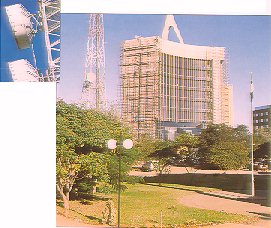


THE microwave network covering a significant part of the country
is a development that should vastly promote Botswana's position
in the world economy. further developments improving both internal
links and those with the outside world will at the same time reduce
the costs of telecommunications services.
The new Botswana Telecommunications headquarters in Gaborone.
Inset: Microwave dishes on the main tower of the building.
The Botswana Telecommunications Corporation (BTC), established as a commercial entity in 1`980, is charged with the provision, development, operation and management of the country's national and international telecommunications services. This corporation has achieved significant growth over the last five years and is in the process of developing a network unequalled throughout the whole of Africa. Over the past decade BTC has increased its capacity from 10 600 lines to 50 700. By the end of the first quarter of the 1994/5 financial year a further 39 villages will be provided with telecommunication service. Emphasis on the development of the network has remained the priority of the corporation and, with completion of a third phase in its main development programme in 1994, a total of almost P250 million will have been invested on the microwave ring around Botswana which covers a distance of 3550 kilometres. For high density, high usage areas, optical fibre cable is being used to reinforce and complement as well as diversify the microwave system. Fibre installations occur mainly in urban networks where they facilitate data services, Botspac and telephone conversations. A major expansion is currently under way with the installation of 900 kilometres of optical fibre systems from Jwaneng to Rampokgwebane with extensions to Orapa and Serowe.
In bringing state-of-the-art communications to previously isolated areas, BTC is able to provide a high quality telephone service to all major areas of Botswana. Training continues to be an activity which occupies a central position and is undertaken at an intensified level. Extensions to both training accommodation and equipment installation have been completed, and a transmission laboratory and an Ericsson AXE training exchange are now available. Use of the new long distance cables will provide Botswana with reliable telecommunications links well into the 21st century, and Botswana can look forward to future applications of fibre which include relaying of television signals and high speed data links. When completed and commissioned, these and many other projects both currently in progress and planned will place the system of the Botswana Telecommunications Corporation among the most advanced in Africa.

 go back
go back